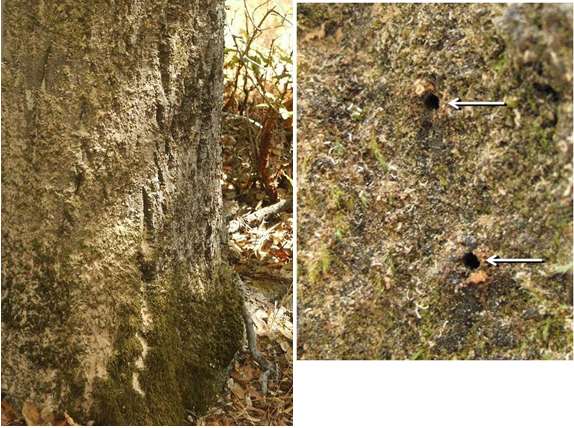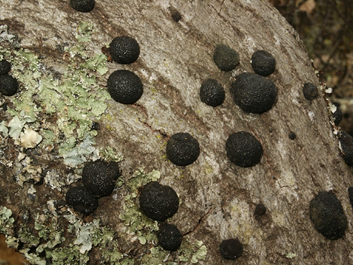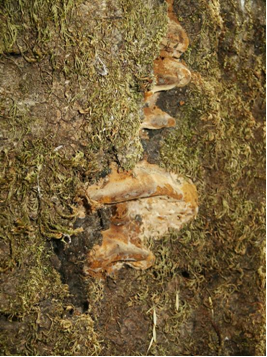
Secondary agents, including wood-boring beetles and decay fungi, eventually invade most large P. ramorum cankers. These secondary agents destroy the sapwood, thereby cutting off the water supply to the tree canopy.
Ambrosia and bark beetles (including Monarthrum and Pseudopityophthorus spp.) commonly colonize P. ramorum cankers on oaks and tanoaks. These small beetles often attack the stem shortly after bleeding first appears, but beetle boring may not appear for a year or more after bleeding is seen. Small cankers and cankers in small-diameter oaks and tanoaks may not be attacked by beetles.
Ambrosia and bark beetles produce numerous pinhead-sized holes in the affected area as they bore through the bark (fig. 1-11). In active invasions, copious amounts of fine wood dust are ejected from the boring holes. Boring dust accumulates in bark fissures and at the base of the tree. Accumulated boring dust can wash or blow away after beetles leave the tree. At that point, the tiny beetle holes can be difficult to see in the bark, but evidence of previous beetle activity can be seen in cut or broken stems. Older cankers and branches of SOD-infected trees may be invaded by larger wood-boring beetles (commonly flat-headed borers, family Buprestidae).

Figure 1-11óBeetle boring dust on coast live oak. At right, detail shows small (about 1 mm diameter) exit holes of wood boring beetles on a tree infected with Phytophthora ramorum.
Wood decay fungi, especially Annulohypoxylon (formerly Hypoxylon) thouarsianum and Phellinus gilvus also colonize the wood beneath larger cankers. Wood decay is often quite advanced before external fruiting bodies develop. Annulohypoxylon thouarsianum produces hard, black hemispheric fruiting bodies (fig. 1-12). These may develop within the first year after a canker develops, but more commonly appear later, after bark or ambrosia beetle colonization is evident. Phellinus gilvus fruiting bodies (fig. 1-13) typically develop in association with cankers that are at least a year old.

Figure 1-12—Annulohypoxylon thouarsianum fruiting bodies on coast live oak with late stage SOD symptoms.

Figure 1-13—Phellinus gilvus fruiting bodies on coast live oak with late stage SOD symptoms.
Other fungi can also contribute to the decline of SOD-affected trees. Armillaria species commonly colonize the main roots and lower trunk of trees with extensive P. ramorum cankers, causing decay of roots and sapwood in the lower trunk. Preexisting infections by wood-decay fungi including species of Inonotus, Phellinus, Laetiporus, and Ganoderma may expand more rapidly in trees infected by P. ramorum. This accelerated decay hastens tree decline and death, usually by contributing to trunk failure.
Annulohypoxylon thouarsianum, P. gilvus, ambrosia, and bark beetles are opportunistic invaders that also attack trees that have been compromised by other agents. The presence of these secondary organisms alone does not provide evidence that a tree has been infected by P. ramorum. The other wood decay fungi noted above also occur widely in oaks and are not limited to SOD-affected trees.